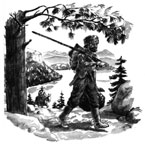 One of the most illustrious and colorful mountain men was French Canadian, Francois Payette. He was born in a small town near Montreal, Quebec, Canada, the youngest of six children. As a young man he worked on Lake Ontario as a canoeman, building log rafts and floating them 300 miles to Quebec. At age 18 in 1810, he went to work for John Jacob Astor and the Pacific Fur Company. The spring of 1812 saw him arriving at the mouth of the Columbia River on the ship "the Beaver," with a small party of fur trappers, who then built Fort Astoria. Two years later Astor sold his business to the Northwest Company.
One of the most illustrious and colorful mountain men was French Canadian, Francois Payette. He was born in a small town near Montreal, Quebec, Canada, the youngest of six children. As a young man he worked on Lake Ontario as a canoeman, building log rafts and floating them 300 miles to Quebec. At age 18 in 1810, he went to work for John Jacob Astor and the Pacific Fur Company. The spring of 1812 saw him arriving at the mouth of the Columbia River on the ship "the Beaver," with a small party of fur trappers, who then built Fort Astoria. Two years later Astor sold his business to the Northwest Company.| Read More Articles by Ron Marlow | Learn More about Mr. Marlow |